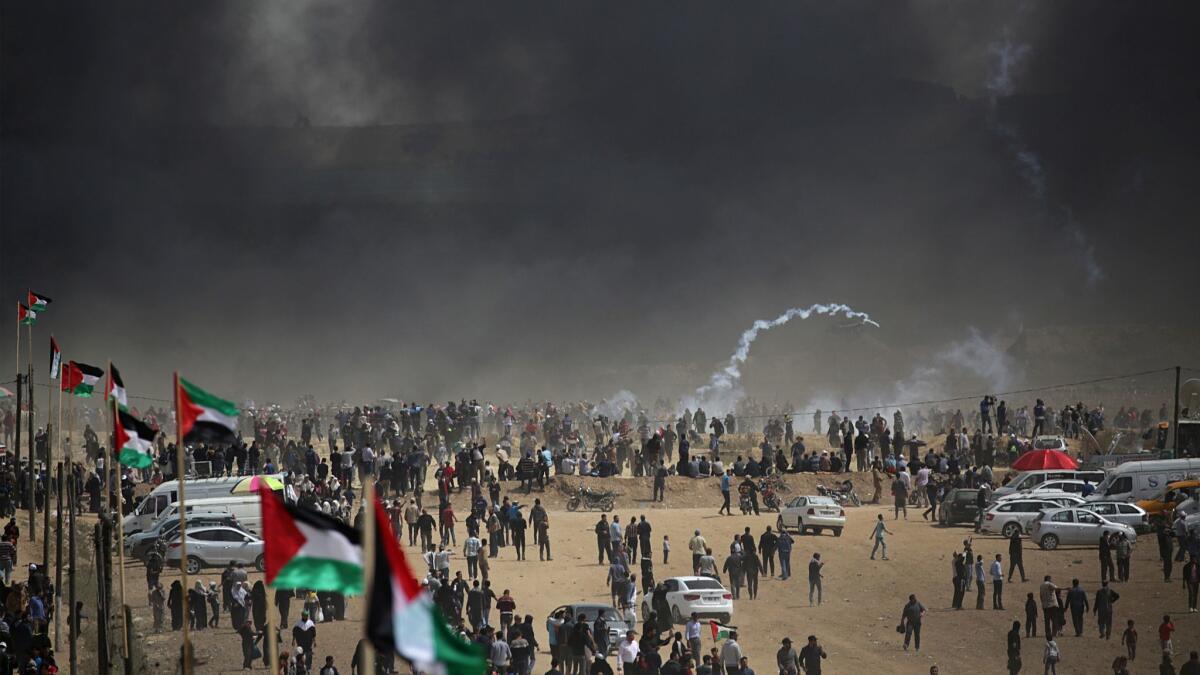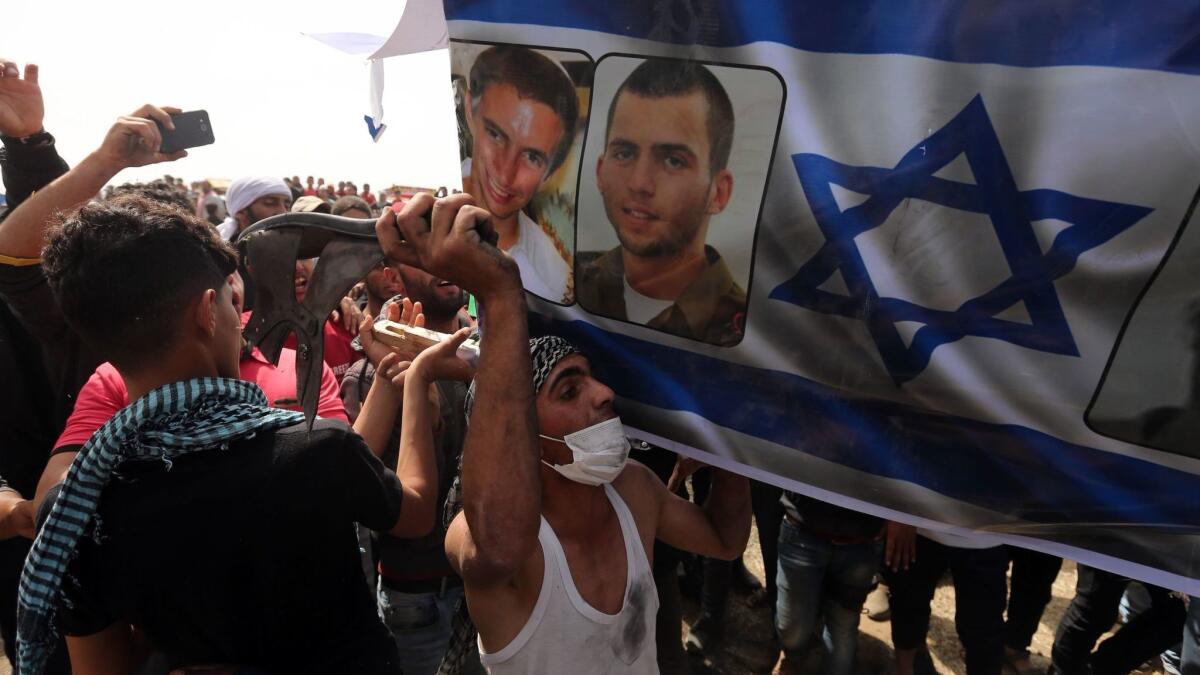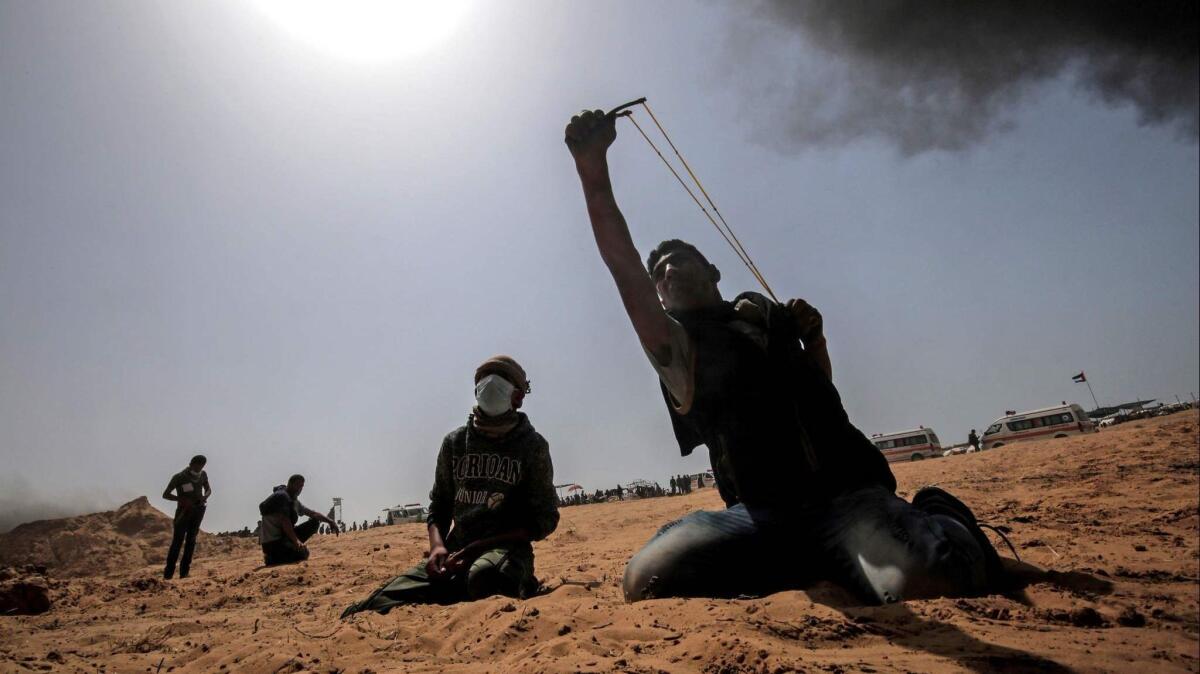Nearly 1,000 Palestinians injured in Gaza-Israel border protests

- Share via
Reporting from Gaza City — Nearly 1,000 people were injured Friday — some overwhelmed by tear gas, others struck by gunfire — as Palestinians again massed along the Israeli border fence in a violent and ongoing protest.
The protest marked the midway point for six mass demonstrations planned by Hamas, the Palestinian Islamist militia that rules the Gaza Strip. The demonstrations are timed to culminate in mid-May, around the date commemorating the 70th anniversary of Israel’s founding and, this year, the start of the Muslim holy month of Ramadan. It is also near the date when President Trump said the U.S. would move its embassy to Jerusalem — a vow that has incensed Palestinians who claim half the city as their own.
Hundreds have been injured in the every-Friday protests and at least 20 Palestinians have been killed by Israeli forces. Palestinians in the Gaza Strip began the protest to demand the right of Palestinian refugees to return to their family homes in what is now Israel.
The Gaza Strip is a cramped 141 square mile enclave of about 2 million people, bounded by Israel, Egypt and the Mediterranean Sea. Israel, the United States, Europe and much of the Arab world, including Egypt, list Hamas, which took over the strip from the Palestinian Authority after a 2007 military conflict, as a terrorist organization.
A group of physicians from Doctors Without Borders entered the Gaza Strip on Friday, and, according to Israel Radio, were treating about 100 people with bullet wounds. But the Health Ministry in Gaza reported that nearly 300 of the 960 people injured had been hit by gunfire and that a 28-year-old man was killed east of Gaza City.

In a statement, the Israeli military said that Friday’s rioting took place in five locations along the border and included “attempts to breach the security infrastructure, … the placement and detonation of an explosive device near the Karni Crossing in the northern Gaza Strip” and the launch of a firebomb attached to a kite.
“Explosive devices, rocks and firebombs have continued to be hurled and several attempts were made to sabotage the security infrastructure,” the Israeli army said.
In a video released by Safa, a Hamas-linked news agency, young Palestinian men, some wearing the white masks of the so-called Anonymous group, are heard chanting, “Allahu akbar” — “God is Great” in Arabic — as they tear apart an oversize facsimile of the Israeli flag stamped with the images of Israeli Prime Minister Benjamin Netanyahu and Defense Minister Avigdor Lieberman.
For the first time, Israeli soldiers this week used loudspeakers to warn the protesters, in Arabic, “Don’t touch the fence! If you do so we will shoot you!”
Israel fears that Hamas’ call for the protests will conclude with a march of thousands potentially breaking through the barrier.
The fence, according to the company that built it, Magal Security Systems, “is meant to detect infiltration, not stop it.”
“It would take about 30 seconds to cross,” Saar Koursh, Magal’s chief executive officer, said in an interview with Bloomberg. “This fence wasn’t built to stop riots like you see now. It was built to give real-time indication if somebody is trying to cross the border.”
The Israeli army warned that it “will not allow any harm to security infrastructure that protects Israeli civilians and will act against the violent rioters and terrorists who threaten either.”
Though considerable, the number of participants in the clashes has consistently fallen since they began three weeks ago, when there were roughly 30,000 marchers. Friday’s gathering also drew less gunfire than previous protests.
In last week’s protests, Yasser Murtaja, 30, a Gazan photographer who was wearing a vest marked “Press” was fatally shot. Israeli authorities have yet to release the findings of an investigation into the circumstances of Murtaja’s death.

On Saturday, Lieberman implied that Murtaja’s death was the result of his use of a drone, common among news photographers. “I don’t know who he is, a photographer, not a photographer — whoever operates multi-rotor drones above Israel Defense Forces soldiers needs to understand that he is endangering himself,” the defense minister said.
The Israeli army declined to endorse Lieberman’s remarks.
Photographs of Murtaja show him using a large camera rig to document the demonstration, but no drone.
“He was using a normal video camera all day,” photographer Ashraf Abu Amra told Agence France-Presse.
On Tuesday, Lieberman referred to Murtaja as “a terrorist” and longtime “member of the military arm of Hamas, holding a rank equivalent to captain,” an accusation repeatedly reiterated by Netanyahu’s press office, with no evidence, during the course of the week.
A file compiled by the International Federation of Journalists, based on an interview with Murtaja, challenged those claims. According to the report, Murtaja was detained by Hamas in 2015 and was beaten by his captors, requiring hospitalization, when he resisted their attempts to force him into a vehicle after he covered a home demolition.
Further casting doubt on the Israeli claims, the U.S. State Department confirmed that a media company co-founded by Murtaja was awarded a U.S. government grant last month.
State Department spokeswoman Heather Nauert said Murtaja had passed the strict vetting process imposed “to ensure grant recipients have no ties to militant organizations or activities.”
The Norwegian Refugee Council, which recently hired Murtaja to document the impact of persistent violence experienced by children in Gaza, expressed “outrage” at his death.
Special correspondents Tarnopolsky reported from Jerusalem and Abu Alouf from Gaza City.
More to Read
Sign up for Essential California
The most important California stories and recommendations in your inbox every morning.
You may occasionally receive promotional content from the Los Angeles Times.










